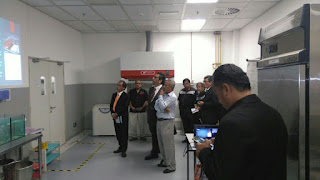PS Aquatics
Thursday, 26 January 2017
Tuesday, 10 January 2017
Salinity and Hatching Brine Shrimp Eggs
Brine shrimp are tiny crustaceans that live in salt water. This means that they’re related to crabs, lobsters, and other shrimp. However, brine shrimp are much smaller than other shrimp, and they make intriguing pets. In this experiment, you’ll see how different amounts of salt change the hatching rates of brine shrimp.
The ocean and some lakes are salty, and this salt comes from the rocks in the water. You can’t see the salt in the water because it is dissolved, but it has a big impact on the creatures that can live in an environment. The amount (or concentration) of salt in the water is called salinity.
Brine shrimp have an interesting life cycle. The adult shrimp lays cysts that contain baby shrimp. These cysts have a superpower: if conditions in the environment are bad, they will stay dormant for a while and wait until conditions improve before they hatch.
For this experiment, you’ll get three different containers and make them each into a different ocean. Create a hypothesis, your best guess as to what is going to happen. Will the brine shrimp prefer water that’s very salty, somewhat salty, or not very salty?
Problem:
What is the ideal salinity for hatching brine shrimp?
Materials
1. Three clear, one quart plastic containers
2. Three quarts of distilled water
3. Tablespoon
4. Four tablespoons of aquarium salt
5. ¾ tablespoon brine shrimp eggs
6. Teaspoon
7. Wooden spoon
8. Magnifying glass or microscope
9. 3 petri dishes
10. Notepad
11. Pencil
1. Three clear, one quart plastic containers
2. Three quarts of distilled water
3. Tablespoon
4. Four tablespoons of aquarium salt
5. ¾ tablespoon brine shrimp eggs
6. Teaspoon
7. Wooden spoon
8. Magnifying glass or microscope
9. 3 petri dishes
10. Notepad
11. Pencil
Procedure
- Fill each container with a quart of warm distilled water.
- Get your aquarium salt, and stir half a tablespoon of salt into the first container, one tablespoon into the second, and two tablespoons into the last. Label the containers.
- Stir until the salt is dissolved, and check for crystals on the bottom before you go on.
- Now it’s time to add the baby shrimp! Stir in a quarter tablespoon of eggs in each container.
- Put the containers on a sunny window ledge or under a light.
- Make sure that the water stays warm, but not too hot. It should be room temperature. Why is the room light and at room temperature important?
- Gently stir the water every few hours. Why do you need to stir the water?
- Over the next two days, watch the baby shrimp hatch. Take notes about the progress in each container.
- After 48 hours, take a teaspoon-sized sample from each container, and place the sample in a small, clear container such as a petri dish.
- Look at each sample with your magnifying glass and see how many shrimp have hatched. If you have a microscope, this is a good time to use it, because you’ll be able to see the shrimp babies very clearly.
- Go back the next day and take another sample. Which container has the most baby shrimp?
Results
Brine shrimp do best at a salinity of 1 2/3 tablespoons of salt per quart of water.
Why?
Before it is born, a brine shrimp lives in a cyst. When conditions are right, the babies will hatch. These babies are called nauplii. If conditions are bad, the females release dormant cysts. These cysts don’t turn into babies and hatch until the conditions are good. That way, the nauplii will have the best chance of survival.
Before it is born, a brine shrimp lives in a cyst. When conditions are right, the babies will hatch. These babies are called nauplii. If conditions are bad, the females release dormant cysts. These cysts don’t turn into babies and hatch until the conditions are good. That way, the nauplii will have the best chance of survival.
What makes brine shrimp happy? Shrimp develop at different rates depending on the conditions around them. They like to have lots of oxygen in the water – you added oxygen when you stirred the solution. They also like to have a temperature that’s not too hot and not too cold. Of course, the food needs to be good too: brine shrimp use their bodies to move tiny, microscopic organisms into their mouths.
Brine shrimp also need saltwater. They are tough and can handle very different amounts of salt. Salinity is usually measured in parts per thousand (ppt), which means the number of grams of salt in a kilogram of liquid. Brine shrimp do best at a salinity of nearly 2 tablespoons of salt per quart of water. However, whether they grow and reproduce well depends on all of the other factors in their environment as well.
Depending on the conditions of the place where they live, it can take as little as a week or a many as six weeks for the babies to turn into adults.
Scientists in labs use brine shrimp to test for pollution in water. Many animals like birds eat small animals that live in the water. If the water is polluted, the shrimp may not be as successful, or they may die. You can try other experiments using tiny amounts of cooking oil or dish soap to see how brine shrimp hatching rates change when there is pollution in the water.
What other environmental conditions might change how brine shrimp hatch and grow? How else could you make the best home for your brine shrimp?
Thursday, 31 March 2016
Tuesday, 22 March 2016
Sunday, 13 March 2016
Monday, 4 January 2016
Sunday, 3 January 2016
Subscribe to:
Comments (Atom)
























